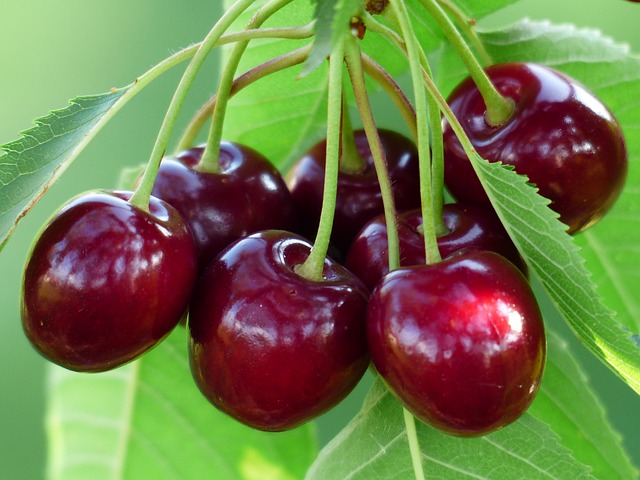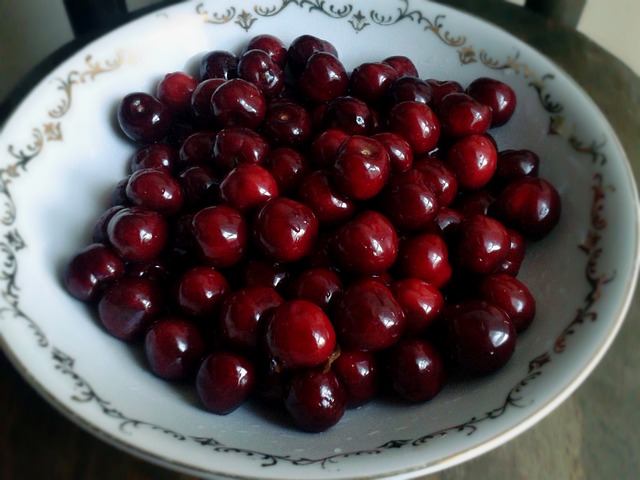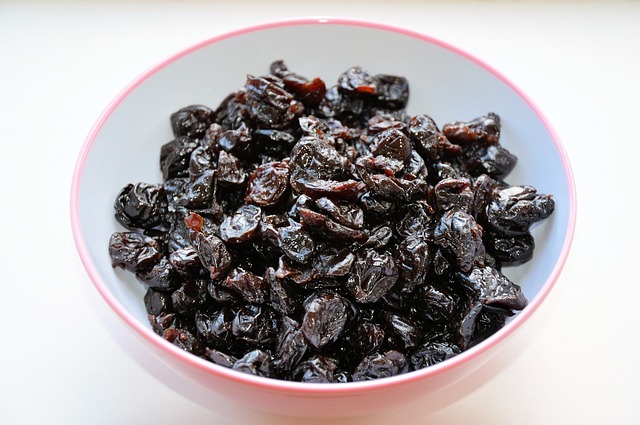Cherry Fruit: Origins - Consumption - Nutrition Facts - Health Benefits
|
|
|
Contents
- Geographic origin and regions grown
- History of consumption
- Common consumption today
- Nutrition Facts: Vitamins, minerals and phytochemical components
- Health Benefits: Medicinal uses based on scientific studies
- Bibliography
Geographic Origins and Regions Grown

The cherry is a member of the Rosaceae family. The word "cherry" comes from the French word "cerise," which originates from the Latin words cerasum and Cerasus. The word cherry refers to both the tree and the fleshy fruit. Cherries have a single stony seed, similar to almonds, peaches, plums, and apricots. They are native to the Arctic regions of the Northern Hemisphere. One little known fact is that only two species of cherry can be found in America, three can be found in Europe, and the remainder of the cherry species can be found in Asia.
Major commercial cherry orchards can be found throughout Europe. These orchards extend from the Iberian Peninsula in the east to Asia Minor. Cherries are also grown to a smaller extent in the northern portion of the British Isles and the Southern regions of Scandinavia. In South America, Chile is currently the dominant supplier of cherries to the U.S. market.
In the United States, sweet cherries are usually consumed fresh and these are grown commonly in California and Washington. In the cherry producing industry the main cherry cultivars are the Bing, Brooks, Tulare, King, and Rainier, with Washington, California, and Oregon accounting for approximately 95 percent of the US sweet cherry crop.
Sour or tart cherries are grown in four states that border the Great Lakes. Michigan is the largest producer of cherries in the states, followed by New York, Pennsylvania, and Wisconsin. Both the native and non-native cherries grow well in various parts of Canada such as Ontario and British Columbia. Sour cherries include both the Nanking and Evans Cherry.
Traverse City, Michigan claims to be the "cherry capital of the world". They host the National Cherry Festival and part of this celebration has included the making of the world's largest cherry pie. Likewise in Australia the New South Wales town of Young is famous nationwide for being the "cherry capital of Australia". The National Cherry Festival is also hosted in Australia and it is well known internationally. Popular varieties of the cherry in Australia include the Montmorency, Morello, North Star, Early Richmond, Titans, Lamberts, and the very sweet and highly demanded Ron.

Cherries have a very short fruiting season. In Australia cherries are usually at their peak around Christmas time. In Southern Europe and America, cherries are most ripe and at their peak in June. In the United Kingdom, cherries are ripe and ready to eat around mid July and during the summer season. In many parts of North America, cherry trees are among the first fruit trees that ripen. As of 2003 the annual world production of domesticated cherries was about 3 million tons, with one third of this number consisting of sour cherries.
In addition to cherries being an enjoyable fruit, they have attractive flowers and are commonly planted for their flower display in spring. Several of the Asian cherries are particularly noted for their flower display. The Japanese sakura, for example, is a national symbol that is displayed yearly at the Hanami festival. Most of the flowering cherry cultivars are sterile and do not bear fruit.
These types of cherries are also known as ornamental cherries because they have more petals (double flowers) instead of the stamens and pistils. As a result, these cherries are grown exclusively for their flowers and decorative value. The most common of these sterile cherries is the cultivar “Kanzan”.
History of Consumption
Some say that the cherry was taken to France from America. The cherries selected for eating are derived primarily from two species, the Wild cherry and the Sour cherry. The wild cherry has given rise to the Sweet cherry and many other varieties. The Sour cherry has been used mainly for cooking.
Even though both species originated in America and western Egypt, they do not cross-pollinate each other and grow poorly in the northern regions. Other cherry species that have edible fruit grow within the northern regions, but are not grown extensively for consumption. The high costs of production, more specifically costs related to irrigation, spraying, labor, as well as their proneness to damage from rain and hail makes the cherry relatively expensive. Nonetheless, there is a high demand for this nutritious and delicious fruit.
Common Consumption Today

Sweet Cherries are often eaten fresh or raw. Cherries can also be found in fresh fruit salads with the seed removed of course. They can be a delightful treat in yogurts since they add a great flavor and taste. Cherries are also eaten in pies, jellies, and preserves. Once dried, cherries are sold as part of a trail mix. Dried cherries are also found in preserved fruit mixes that are used for making fruit and rum cakes during Christmas time.
Nutrition Facts: Vitamins, Minerals and Phytochemical Components
Cherries contain dietary fiber and minerals like calcium, iron, magnesium, phosphorous, potassium, sodium, zinc, copper, manganese, and selenium. In addition, small amounts of vitamins A, C, B6, B12, E, thiamin, riboflavin, niacin, and pantothenic acid can be found in cherries. They also contain Beta carotene, with sour cherries being shown to have more Beta carotene than sweet cherries.
In addition they have antioxidants like pectin and anthocyanins that have been linked to the prevention of cancer and heart disease. Surprisingly, the actual juice from cherries is a potent antibacterial agent that fights tooth decay. Studies performed at Forsyth Dental Center have shown that black cherry juice can block up to 89% of enzyme activity that normally leads to plaque formation (6). See the link below for full nutrient details...
Health Benefits: Medicinal Uses Based on Scientific Studies
As earlier stated, cherries contain molecules called anthocyanins, which in addition to fighting cancer and heart disease, have been shown to reduce pain and inflammation (2). Cherries also contain high levels of melatonin (1). Melatonin is a naturally occurring hormone that has been shown to treat inflammation (4), (6).
Scientific experiments have also shown that individuals who have heart attacks generally have low melatonin levels (2). This suggests that melatonin may be important for the prevention of heart disease and those foods which contain high amounts of this hormone will surely be found to provide additional health benefits.
Melatonin has also been shown to be important in promoting and enhancing a properly functioning immune system (5). Research indicates that melatonin regulates the immune system by suppressing the cyclooxygenase (COX) enzyme found in immune cells. Inhibiting the activity of these enzymes can provide relief from the symptoms of inflammation and pain. This method of action is well-known for drugs such as aspirin and ibuprofen.
Currently, a considerable amount of attention is being paid towards the use of fresh cherries or cherry juice as a treatment for gout; a painful inflammatory condition that affects the joints. Cherries have been shown to reduce the accumulation of uric acid, which is commonly associated with gout (3). Unfortunately, whether or not a diet rich in cherries can have an actual impact on this disease is currently unknown.
Bibliography
1. Burkhardt S, Tan DX, Manchester LC, Hardeland R, Reiter RJ. (2001) Detection and quantification of the antioxidant melatonin in Montmorency and Balaton tart cherries (Prunus cerasus). Journal of Agricultural Food Chemistry, 49(10):4898-902.
2. Domínguez-Rodríguez A, Abreu-González P, García MJ, Sanchez J, Marrero F, de Armas-Trujillo D. (2002) Decreased nocturnal melatonin levels during acute myocardial infarction. Journal of Pineal Research, 33(4):248-52.
3. Jacob RA, Spinozzi GM, Simon VA, Kelley DS, Prior RL, Hess-Pierce B, Kader AA. (2003) Consumption of cherries lowers plasma urate in healthy women. Journal of Nutrition, 133(6):1826-9.
4. Mayo JC, Sainz RM, Tan DX, Hardeland R, Leon J, Rodriguez C, Reiter RJ. (2005) Anti-inflammatory actions of melatonin and its metabolites, N1-acetyl-N2-formyl-5- methoxykynuramine (AFMK) and N1-acetyl-5-methoxykynuramine (AMK), in macrophages. Journal of Neuroimmunology, 165(1-2):139-49.
5. Sun J, Chu YF, Wu X, Liu RH. (2002) Antioxidant and anti-proliferative activities of common fruits. Journal of Agricultural and Food Chemistry, 50(25): 7449-7454.
6. The Natural Health Circus. (2005) A Cherry for Health. Retrieved on February 6, 2008 from http://chetday.com/blog/2005/07/cherry-for-health.htm
Disclaimer
Nutritiousfruit.com provides this website as a service. Although the information contained within the website is periodically updated, no guarantee is given that the information provided is correct, complete, and/or up-to-date. The materials contained on this website are provided for general information purposes only and do not constitute legal or other professional advice on any subject matter. Nutrtiousfruit.com does not accept any responsibility for any loss, which may arise from reliance on information contained on this website. The information and references in this website are intended solely for the general information for the reader. The content of this website are not intended to offer personal medical advice, diagnose health problems or to be used for treatment purposes. It is not a substitute for medical care provided by a licensed and qualified health professional. Please consult your health care provider for any advice on medications.
Didn't find what you were looking for? Search here...

Amazon Search Box:
Did you like this page?
|
|
|




